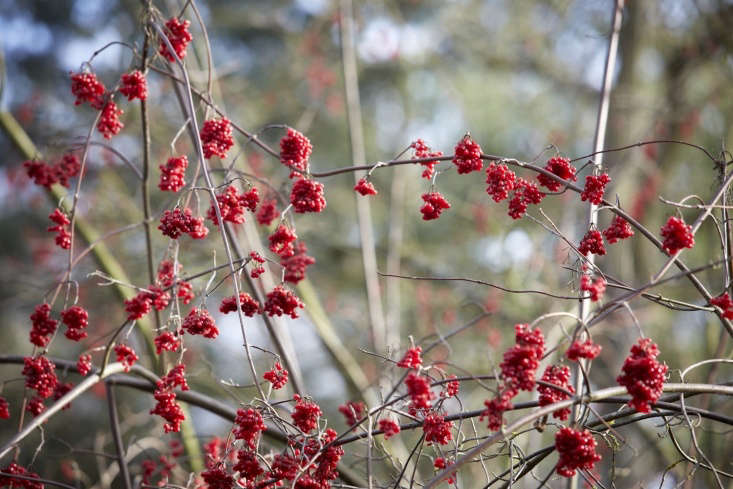With their delicate blossoms and brilliantly colored berries, the twigs of winter deserve applause. Branches look like floral arrangements in the garden (and can also be brought indoors). On a recent visit to the Royal Horticultural Society’s gardens at Wisley in Surrey, our talented photographer Britt Willoughby Dyer captured the twigs of winter at their best: They make a picture in the garden.
Here are seven twiggy favorites to plant in your own garden for winter drama.
Photography by Britt Willoughby Dyer for Gardenista.
Ghost Bramble

Evergreens are all very well; they bring a touch of the unexpected to a garden in late winter. Here, Rubus cockburnianus forms a (well-maintained) tangle by a lake.
A tunnel of ghost bramble may not be an obvious take-home idea, yet its strange beauty has a different inspiration: a focus on stems and branches. At this time of year, detail comes to the fore, giving character to the most well-ordered garden.
Viburnum ‘Foetens’

Branches with flowers and scent have the edge in an otherwise dormant garden. Winter-flowering viburnums wait for last year’s leaves to drop before pink buds appear, followed by fresh foliage. Visually, this chronology works well for the small but highly scented flowers.
Viburnum ‘Charles Lamont’

Flowery twigs are best examined at close quarters and make an easy flower arrangement indoors. The raggedy shape of these shrubs makes the decision of cutting them for the house quite easy. Viburnum x bodnantense can reach a height of about eight feet; pruning should be done selectively, by cutting back a few of the oldest stems at the base.
Birch-Leafed Viburnum

One of the best-loved viburnums, V. opulus, with its snowballs of blossom in spring, finely shaped leaves, and red berries in early winter, doesn’t have much left to show at this time of year. Which is why birch-leafed viburnum, V. betulifolium, is such good value. Berries held in scarlet clusters, flattered by bare twigs, look better than they taste apparently, since birds leave them alone.
Winter Cherry

Winter cherry is one of the best small trees to choose. With vibrant autumn color and a classically round prunus shape, Prunus x subhirtella ‘Autumnalis Rosea’ has tiny cherries and tiny blossoms. It flowers on and off through winter, in a spring preview.

Witch Hazel

Witch hazel is not grown enough, yet its arresting, richly colored flowers coincide with the dregs of winter. Plant it where its ribbon-shaped petals will be lit up by sunshine. Hamamelis x intermedia ‘Rubin’ is slightly scented; a strongly scented variety is H. x intermedia ‘Aphrodite’ or the traditional Chinese witch hazel, Hamamelis mollis.

Wintery branches that retain their dried leaves, such as beech or hornbeam, add to a garden’s atmosphere in winter. When last year’s decay is mixed with this year’s color, so much the better. Poking through the perfectly mulched ground here at the RHS headquarters in Surrey are spears of Iris reticulata.
Honeysuckle ‘Winter Beauty’

People of a tidy bent can be just as irritated with winter-flowering honeysuckle as its summer counterpart. In fact, it’s easy to keep both in check if you have secateurs and twine handy when moving around the garden. They don’t mind being thinned and neatened; only wait until the flowering has finished.
Some people resort to hiding the winter varieties behind something that behaves better, to enjoy the scent without being offended by the nest of twigs. But as long as their height is kept in check and they flower at nose and eye level, I don’t see how they could be a problem.

No winter landscape should be devoid of drama. For more ideas to add color against gray skies, see our Garden Design 101 guides, especially Red Twig Dogwood 101 and Shrubs 101. Read about more of our favorite winter-worthy shrubs:
- Sweet Box: A Field Guide to Growing, Care & Design.
- Landscape Ideas: Boxed in by Boxwood? 5 Favorite Shrubs to Try Instead.
- Paperbush 101: A Field Guide to Planting, Care & Design.
- Landscaping 101: How to Plant a Bare Root Hedge.
- 10 Garden Ideas to Steal from Vita Sackville-West at Sissinghurst Castle.
- Shrubs 101: A Field Guide to Planting, Care & Design.
- 7 Fragrant Favorites: Winter-Flowering Scented Shrubs.
Finally, get more ideas on how to plant, grow, and care for various shrubs and hedges with our Shrubs: A Field Guide.








Have a Question or Comment About This Post?
Join the conversation